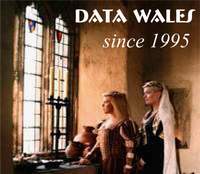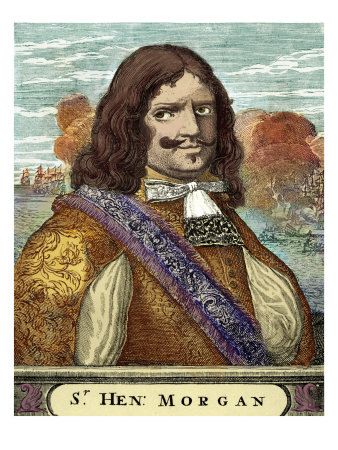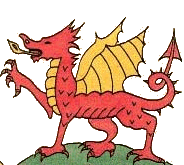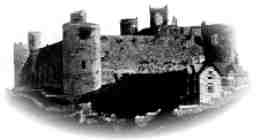 |
|
 |
|
|
A Welsh Buccaneer This Article © John Weston from Data Wales Reprinted here with permission for our Welsh History research pages
According to some accounts Henry Morgan was born at Llanrumney (in Welsh, Llanrhymny). In those days, Llanrumney was a manor in the ancient Hundred of Newport in Monmouthshire but nowadays is thought of as a suburb of Cardiff. The manor had been the property of the ancient family of Kemeys but an heiress married Henry Morgan of Machen in the 16th century and the Morgans were here for six generations. However, towards the end of his life Henry Morgan is said to have bought an estate in Jamaica and named it Penkarne. The manor of Pencarn (again in the Hundred of Newport) was itself associated with the Morgans for many centuries. An ancestor Owen, son of the Lord of Caerlleon, lived there in the 12th century. Sir Thomas Morgan of Pencarn became known as “the warrior” after commanding English forces overseas in the 1580s and 1590s. His nephew, Sir Matthew Morgan was wounded at the siege of Rouen in 1591. Matthew’s brother, Sir Charles also served overseas with distinction and became a member of the Privy Council of King Charles I. A brief note of his career (revised March 2000) Of the generally available literature on Henry Morgan, I have found Dudley Pope’s “Harry Morgan's Way” (Secker and Warburg, London 1977) to be the most satisfactory and I have followed this in describing Morgan’s exploits. Dudley Pope consulted British and Spanish archives and brought his wide knowledge of maritime history to the topic. It is worth remembering that Morgan’s raids were carried out in his capacity as a “privateer”. Like commanders in many colonial outposts of the time, he was authorized to act as an agent of his country at a time when official government forces were often not available so far from home. His reports to the governor of Jamaica and papers between Jamaica and London survive. His own official reports of his exploits are usually laconic in the extreme and seem to reveal a naturally modest man, not comfortable with the sometimes rather flowery prose of his day. As he once wrote, “I ... have been more used to the pike than the book..."
Henry learned much from Commodore Christopher Mings when he sailed as part of the flotilla which first attacked and plundered Santiago (Cuba) and in 1663 when he commanded a vessel in the attack on the Mexican coast. In this, 1100 men described as privateeersmen, buccaneers and volunteers sailed more than 1000 miles to attack Campeche. The town, defended by two forts and regular Spanish troops, fell after a day of fighting and the buccaneers took fourteen Spanish ships from the port as prizes.
Why were buccaneers so called? The original boucaniers were the native inhabitants of the West Indies who had developed a method of preserving meat by roasting it on a barbecue and curing it with smoke. Their fire pit and grating were called a boucan and the finished strips of meat were also known as boucan. In time, the motley collection of international refugees, escaped slaves, transported criminals and indentured servants who roamed along the coasts if the islands became known as buccaneers and the term came to describe an unscrupulous adventurer of the area.
On the expedition mentioned above, the small fleet sailed from Jamaica and rounded the Yucatan peninsula to the Gulf of Mexico. They landed at Frontera and marched 50 miles inland to attack Villahermosa. After sacking this town they found that their own ships had been captured by the Spanish so they had to themselves capture two Spanish ships and four coastal canoes in which to continue their epic voyage. They sailed and paddled 500 miles against an adverse current to return around the Yucatan peninsular and continued along the coast of Central America. They landed on the coast of modern Nicaragua and again struck inland to attack a rich town called Granada. This was taken in a surprise raid and the official report said that more than a thousand of the Indians “joined the privateers in plundering and would have killed the (Spanish) prisoners, especially the churchmen...”.
Later in 1668, Morgan sailed with ten vessels to Cow Island off the coast of Hispaniola (modern Haiti). Here the Oxford, a warship sent out for the defense of Jamaica by the British government, found the French privateer ship Le Cerf Volant. The British master of a ship from Virginia had accused the French vessel of piracy so the Cerf Volant was arrested and condemned as a prize by the Jamaica Court of Admiralty. After the Oxford was blown up (in an explosion said to have killed 250 people) while Morgan dined in the great cabin, the Cerf Volant ultimately became his flagship, under the new name of Satisfaction. After cruising east along the coast of Hispaniola and attacking coastal towns along the way, Morgan turned south to sail across the Caribbean again, making for Maracaibo in the Gulf of Venezuela. This he took, together with the more southerly town of Gibraltar. On their return journey, the privateers were bottled up at the lake of Maracaibo by several large Spanish warships and a reinforced fort. Morgan had to use great ingenuity to escape. While doing so added to his treasure yet again.
Morgan returned to Jamaica minus his ship the
Satisfaction which had been wrecked on a reef but his fleet docked at Port
Royal with hundreds of slaves and chests of gold, silver and jewels. Under
the strict agreement that governed the division of the spoils in those
days, Dudley Pope estimates that Morgan would have made 1000 British pounds
(around 1600 USD) from the Panama expedition and it is known that ordinary
seamen pocketed 200 pieces of eight (worth 50 pounds or 80 dollars).
By the time that the sack of Panama was known in London, politics had taken a turn. There were those who sought to conciliate Spain, especially since reports from some European capitals suggested that she was near to declaring war on England. It was thought prudent to arrest Modyford, the governor of Jamaica and later to arrest Morgan. In 1672 Morgan sailed for London in the Welcome, a leaky naval frigate. He arrived in a country which differed greatly to the one he had left seventeen years before. Then it had been Puritan, now the monarchy had been restored and London was once more a city of theatre, fashion, corruption and fascinating figures. Some of Christopher Wren’s new classically inspired churches already adorned the city and the diarist Samuel Pepys became secretary to the Board of Admiralty in 1673. There is no record of Morgan having been detained and he seems to have spent three years in London at his own expense but free to meet the people he chose. He became friendly with the second duke of Albermarle (Morgan’s uncle had fought with the duke’s father in the Civil Wars) and it seems that this friendship brought Morgan to the notice of King Charles II. In time, England’s attitude to Spain changed and when the King became aware that the English colony of Jamaica was under threat again, he asked Morgan for advice about the defence of the island, knighted him and wondered if he might like to return there as Lieutenant Governor.
For many of us today, Henry Morgan is little
more than the name of a “pirate” of yore, but I now see signs of Morgan
being re-evaluated as one of Britain’s most successful military strategists
and as a man with the leadership qualities of an Alexander. He gained the
loyalty of the buccaneers, who followed him without question, and the respect
of kings and princes. Of all the great figures in Welsh history he must
be counted among the most attractive and able.
This Article © John
Weston from Data
Wales
The antecedents of the buccaneer, Sir Henry Morgan. Most writers on Henry Morgan are rather vague
as to his background. His roots in the Welsh County of Monmouthshire are
not disputed but there is uncertainty about his parentage. This may be
as a result of deliberate obfuscation, on his part, during his lifetime.
He lived in troubled times and it is possible that, at times, he was concerned
that his reputation would not enhance the ancient Morgan pedigrees. He says: “The eldest son of Thomas of Machen Plas was another Rowland. Rowland’s second son Henry and Henry’s son Thomas were to Llanrhumney. (The first Henry had married Catherine Kemeys, the heiress of the manor of Llanrhumney. J.W.) Thomas of Llanrhumney’s third son Robert was living in London in 1670. It was Robert’s son Henry who became notorious as Sir Henry Morgan the Buccaneer.” This requires further investigation but Robert Morgan did have a brother called Edward and it is known that the buccaneer’s uncle, when Lt. Governor of Jamaica, was styled Colonel Edward Morgan. Note: Llanrhymny is a place name fraught with problems. It is difficult for non-Welsh speakers to pronounce the spelling changes in English (Llanrhumney or Llanrumney) and even the Welsh spelling is disputed. “Llan” implies an ancient site with religious significance but there are those who say the first syllable should be “Lan” (derived from the Welsh “Nant”) giving the meaning “the bank of the River Rhumney”. Oh - it’s also quite hard to type and get right, try it! This Article © John
Weston from Data
Wales
|
|
(Welsh: Harri Morgan, c. 1635 – 25 August 1688)  Welsh buccaneer Henry Morgan in a coloured picture. Sir Henry Morgan (Welsh: Harri
Morgan, c. 1635 – 25 August 1688) was a Welsh privateer, landowner and,
later, Lieutenant Governor of Jamaica. From his base in Port Royal,
Jamaica, he raided settlements and shipping on the Spanish Main,
becoming wealthy as he did so. With the prize money from the raids he
purchased three large sugar plantations on the island.
Much of Morgan's early life is unknown. He was born in south Wales, but it is not known how he made his way to the West Indies, or how he began his career as a privateer. He was probably a member of a group of raiders led by Sir Christopher Myngs in the early 1660s. Morgan became a close friend of Sir Thomas Modyford, the Governor of Jamaica. When diplomatic relations between the Kingdom of England and Spain worsened in 1667, Modyford gave Morgan a letter of marque, a licence to attack and seize Spanish vessels. Morgan subsequently conducted successful and highly lucrative raids on Puerto Principe (now Camagüey in modern Cuba) and Porto Bello (in modern Panama). In 1668 he sailed for Maracaibo and Gibraltar, both on Lake Maracaibo in modern-day Venezuela. He raided both cities and stripped them of their wealth before destroying a large Spanish squadron as he escaped. In 1671 Morgan attacked Panama City, landing on the Caribbean coast and traversing the isthmus before he attacked the city, which was on the Pacific coast. The battle was a rout, although the privateers profited less than in other raids. To appease the Spanish, with whom the English had signed a peace treaty, Morgan was arrested and summoned to London in 1672, but was treated as a hero by the general populace and the leading figures of government and royalty including Charles II. Morgan was appointed a Knight Bachelor in November 1674 and returned Jamaica shortly afterward to serve as the territory's Lieutenant Governor. He served on the Assembly of Jamaica until 1683 and on three occasions he acted as Governor of Jamaica in the absence of the post-holder. A memoir published by Alexandre Exquemelin, a former shipmate of Morgan's, accused the privateer of widespread torture and other offences; Morgan brought a libel suit against the book's English publishers and won, although the black picture Exquemelin portrayed of Morgan has affected history's view of the Welshman. He died in Jamaica on 25 August 1688. His life was romanticised after his death and he became the inspiration for pirate-themed works of fiction across a range of genres Henry Morgan - Wikipedia |

Origin of the Welsh Red Dragon The dragon has long been a symbol of Wales. It features (in its proper red colour) on the national flag and is often to be found marking goods of Welsh origin. How did this exotic oriental beast find its way to Wales? The dragon was perhaps first seen in Wales in Roman times. The Romans were thought to have gained knowledge of the dragon from their Parthian enemies (in lands later to become part of the great Persian Empire) and it is to be seen carved on Trajan’s column. It is probable that the dragon had been seen in the West much earlier than this, as a result of Alexander the Great’s epic journey which commenced it 334 BC Alexander marched as far as northern India and after his death, the break up of his mighty empire saw an increase in trade with Africa and India and for the first time commerce with China.

This Article © Data
Wales
|

Picture © Data Wales The Men of Harlech The song Men
of Harlech is something of an unofficial anthem in Wales. Every Welsh
person knows the tune and despite the variety of lyrics over the years,
the martial air has become identified with the country’s determination
to retain its identity. Harlech Castle in north Wales, one of the “iron
ring” of castles intended to subdue Wales in medieval times, remains as
a picturesqe reminder of the ultimate futility of the invader’s ambition.
Outside of Wales, the song has become well known as a result of the film Zulu which told the story of a small detachment of soldiers and their epic stand against a huge Zulu army in southern Africa. The soldiers were from a regiment which recruited in south east Wales and the borders and their heroism came to be compared with the bold exploits of their ancestors in ancient days. The song would have been known in Wales before the Zulu War but was it actually sung at the battle of Rorke’s Drift? The curator of the unit’s regimental museum thinks it unlikely, since the song (first published in 1860) was only officially adopted by the regiment in 1881, whereas the action depicted in the film took place in 1879. Although we have the 1860 lyrics of the song, we do not have the version from the film. This was written especially for the film and enquirers are advised to seek the copyright holders (whoever they may be). Just who were the Men of Harlech and how did they come to be associated with a bloody battle in Africa? The answer is to be sought through the mists of time and the story starts in the year 1283 when King Edward I ordered a mighty castle to be built at Harlech on the coast of Merionethshire in north Wales. This was just one of a ring of great castles designed to prevent the Welsh from challenging the sovereignty of England. The task of designing and building the castle was given to the Master of the King’s Work in Wales, James of St. George. This man, one of the great military engineers of history, built a castle of the concentric type defended at the back by the sea and at the front by massive towers and walls up to twelve feet thick. The defences of Harlech Castle were first tested
in 1294 when a 37 strong garrison fought off Welsh besiegers led by Madog.
In the next century the castle became neglected but was repaired before
the occasion of the revolt led by Owain Glyndwr. After a long and grim
siege Harlech was captured by Owain in 1404. The revolt could not be sustained,
however, and the castle was recovered for the crown in 1408. Eventually famine forced surrender and Dafydd handed the castle to Lord Herbert and his brother Sir Richard Herbert on honourable terms. King Edward IV at first refused to honour the terms of the settlement but Sir Richard Herbert, out of respect for the bravery of the defenders, offered his own life in exchange for Dafydd’s rather than see his promise broken. These defenders were the Men of Harlech commemorated in the song. Harlech Castle enjoyed 200 years of peace but became a testament to the genius of the designer, Master James, when it endured a further long siege in the first part of the Civil War. It finally surrendered to Oliver Cromwell’s forces in 1647. The South Wales Borderers and Monmouthshire Regimental Museum has paintings depicting the actions in the Zulu War. The regimental chapel in Brecon Cathedral holds the Queen’s Colour, the banner which was recovered from a nearby river after the battle of Isandhlwana. Lieutenants Melvill and Coghill were cut down in its defence and were posthumously awarded Britain’s highest military honour, the Victoria Cross. The bravery of the defenders of Rorke’s Drift was also recognised when Lieutenant Bromhead and six soldiers were awarded the Victoria Cross. They might not have sung the song, not all of them were Welsh, but no one would dispute that they were Men of Harlech. I have located the Monmouthshire resting place of one of the soldiers who won the Victoria Cross at Rorke’s Drift and will add a photograph of this when time permits. Welsh people have always taken the song Men of Harlech on their wanderings around the world but the film Zulu introduced it to lots of people who simply enjoyed the song as a traditional, rousing, martial air. Mr. B. M. of California wrote with a delightful anecdote of his student days at Pomona College. I asked permission to publish it here since his note also reminded me of William Randolph Hearst’s connection with Wales. This Article © by John
Weston from Data
Wales
|
|
Died in 1456.
The illustration is based on the brass at St. David’s Cathedral in Pembrokeshire, west Wales. Edmund’s tomb was originally at the church of the Grey Friars, Carmarthen but was moved at the time of the dissolution of the monasteries. In 1641 and in 1644 Puritan parliaments ordered the removal and defacement of images, crosses, pictures and monuments. Churches around the land were desecrated and the tomb was attacked. The picture represents the restoration of around 1872 but I have removed the great helm upon which Edmund’s head rests in the original and also the hound at his feet. This was done simply to make the outlines of the armour more easily visible. In his “Welsh Monumental Brasses” J. M. Lewis implies that the restoration is probably quite accurate but points out that the tomb must date from after the accession of Edmund’s son as king. The armour pictured is that of the 1480s whereas Edmund died in 1456. This Article © 2000 by John
Weston from Data
Wales
|

Webpage © 1995-2017
Isle of Standauffish
These Articles © Data
Wales